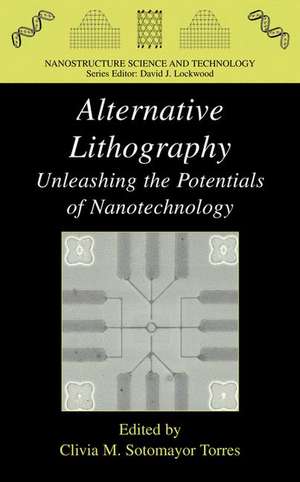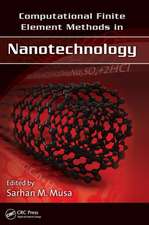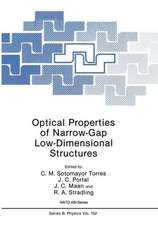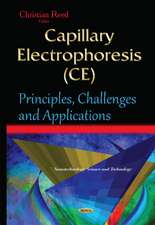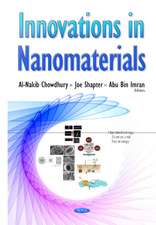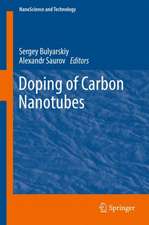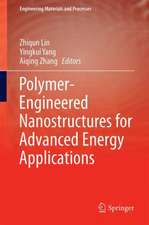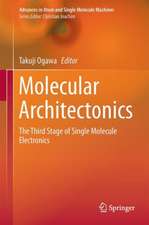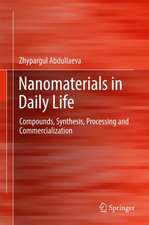Alternative Lithography: Unleashing the Potentials of Nanotechnology: Nanostructure Science and Technology
Editat de Clivia M. Sotomayor Torresen Limba Engleză Hardback – 31 dec 2003
| Toate formatele și edițiile | Preț | Express |
|---|---|---|
| Paperback (1) | 947.50 lei 6-8 săpt. | |
| Springer Us – 20 sep 2012 | 947.50 lei 6-8 săpt. | |
| Hardback (1) | 959.98 lei 6-8 săpt. | |
| Springer Us – 31 dec 2003 | 959.98 lei 6-8 săpt. |
Din seria Nanostructure Science and Technology
- 18%
 Preț: 1114.65 lei
Preț: 1114.65 lei - 18%
 Preț: 1001.02 lei
Preț: 1001.02 lei - 24%
 Preț: 834.59 lei
Preț: 834.59 lei -
 Preț: 405.66 lei
Preț: 405.66 lei -
 Preț: 405.28 lei
Preț: 405.28 lei - 18%
 Preț: 947.35 lei
Preț: 947.35 lei - 18%
 Preț: 734.27 lei
Preț: 734.27 lei - 15%
 Preț: 696.02 lei
Preț: 696.02 lei - 20%
 Preț: 585.30 lei
Preț: 585.30 lei - 20%
 Preț: 556.90 lei
Preț: 556.90 lei - 15%
 Preț: 646.62 lei
Preț: 646.62 lei - 18%
 Preț: 947.50 lei
Preț: 947.50 lei -
 Preț: 397.97 lei
Preț: 397.97 lei -
 Preț: 406.05 lei
Preț: 406.05 lei - 18%
 Preț: 967.08 lei
Preț: 967.08 lei - 18%
 Preț: 947.50 lei
Preț: 947.50 lei - 18%
 Preț: 948.29 lei
Preț: 948.29 lei - 18%
 Preț: 950.03 lei
Preț: 950.03 lei - 18%
 Preț: 951.29 lei
Preț: 951.29 lei - 18%
 Preț: 948.92 lei
Preț: 948.92 lei - 18%
 Preț: 960.13 lei
Preț: 960.13 lei - 19%
 Preț: 559.02 lei
Preț: 559.02 lei - 15%
 Preț: 694.69 lei
Preț: 694.69 lei - 15%
 Preț: 635.15 lei
Preț: 635.15 lei - 15%
 Preț: 640.06 lei
Preț: 640.06 lei - 18%
 Preț: 948.79 lei
Preț: 948.79 lei - 20%
 Preț: 564.28 lei
Preț: 564.28 lei - 20%
 Preț: 628.34 lei
Preț: 628.34 lei - 15%
 Preț: 647.59 lei
Preț: 647.59 lei - 15%
 Preț: 643.16 lei
Preț: 643.16 lei - 15%
 Preț: 643.34 lei
Preț: 643.34 lei - 18%
 Preț: 955.08 lei
Preț: 955.08 lei - 15%
 Preț: 587.72 lei
Preț: 587.72 lei - 15%
 Preț: 649.87 lei
Preț: 649.87 lei - 15%
 Preț: 646.43 lei
Preț: 646.43 lei -
 Preț: 388.72 lei
Preț: 388.72 lei - 18%
 Preț: 955.25 lei
Preț: 955.25 lei - 5%
 Preț: 716.76 lei
Preț: 716.76 lei - 18%
 Preț: 952.89 lei
Preț: 952.89 lei - 18%
 Preț: 1258.46 lei
Preț: 1258.46 lei
Preț: 959.98 lei
Preț vechi: 1170.71 lei
-18% Nou
Puncte Express: 1440
Preț estimativ în valută:
183.72€ • 191.09$ • 151.67£
183.72€ • 191.09$ • 151.67£
Carte tipărită la comandă
Livrare economică 12-26 aprilie
Preluare comenzi: 021 569.72.76
Specificații
ISBN-13: 9780306478581
ISBN-10: 0306478587
Pagini: 333
Ilustrații: XXI, 333 p.
Dimensiuni: 155 x 235 x 28 mm
Greutate: 0.86 kg
Ediția:2003
Editura: Springer Us
Colecția Springer
Seria Nanostructure Science and Technology
Locul publicării:New York, NY, United States
ISBN-10: 0306478587
Pagini: 333
Ilustrații: XXI, 333 p.
Dimensiuni: 155 x 235 x 28 mm
Greutate: 0.86 kg
Ediția:2003
Editura: Springer Us
Colecția Springer
Seria Nanostructure Science and Technology
Locul publicării:New York, NY, United States
Public țintă
ResearchCuprins
1. Alternative Lithography.- 1.1 Introduction.- 1.2 Moulding polymers in the nanometer scale.- 1.3 Microcontact printing.- 1.4 Scanning probe aproaches.- 1.5 Applications.- 1.6 Recent nanofabrication experiments.- 1.7 Status and perspectives.- 2. Nanoimprint Lithography.- 2.1 Introduction.- 2.2 Nanoimprint lithography (NIL) Principle and process.- 2.3 Resolution.- 2.4 3-D patterning.- 2.5 Imprint over non-flat surfaces.- 2.6 Uniformity and submicron alignment over 4 inch wafers.- 2.7 Different imprint machines.- 2.8 Applications.- 2.9 Summary and future.- 3. Viscoelastic Properties of Polymers.- 3.1 Introduction.- 3.2 Squeezing flow of a Newtonian liquid in HEL.- 3.3 Viscoelastic properties of polymers.- 4. Nanorheology.- 4.1 Introduction.- 4.2 Basics of thin film rheology.- 4.3 Hot embossing in practice.- 4.4 Looking ahead.- 5. Wafer Scale Nanoimprint Lithography.- 5.1 Introduction.- 5.2 Special requirements for large wafer scale NIL.- 5.3 Fabrication of a nanoimprint lithography system.- 5.4 Nil Equipment design.- 5.5 Imprint processing.- 5.6 Discussion and conclusions.- 6. Step And Stamp Imprint Lithography.- 6.1 Introduction.- 6.2 Step and stamp imprinting lithography.- 6.3 Pattern transfer using step and stamp imprint lithography.- 6.4 Mix and match with UV lithography.- 6.5 Pattern reproduction.- 6.6 Conclusions.- 7. Step and Flash Imprint Lithography.- 7.1 Introduction.- 7.2 Process overview.- 7.3 Template fabrication.- 7.4 Surface treatment.- 7.5 Etch barrier.- 7.6 Reliability.- 7.7 Patterning results.- 8. Using PDMS as a thermocurable resist for a mold assisted imprint process.- 8.1 Introduction.- 8.2 PDMS material.- 8.3 Technological implementation.- 8.4 Results.- 8.5 Conclusions and domains of application.- 9. Molecules for Microcontact Printing.- 9.1 Introduction.- 9.2 Quality of printed SAMs.- 9.3 Microcontact printing of etch resists.- 9.4 Printing functional adsorbates.- 9.5 Printing on other substrates.- 9.6 Microcontact printing in bio-applications.- 9.7 Conclusions.- 10. Microcontact Printing Techniques.- 10.1 Introduction.- 10.2 The self-assembly of alkanethiols.- 10.3 The stamp.- 10.4 Properties of poly(dimethyl siloxane) elastomers.- 10.5 Stamps for microcontact printing.- 10.6 Stamp fabrication.- 10.7 The microcontact printing process.- 10.8 Substrates for microcontact printing.- 10.9 Printing conditions.- 10.10 Chemical etching.- 10.11 Microcontact printing using ultrathin stamps.- 10.12 A multilevel process: Mix and Match with accurate alignment of the RCP.- 11. Local Oxidation Nanolithography.- 11.1 Introduction.- 11.2 Local oxidation modes.- 11.3 Liquid meniscus.- 11.4 Kinetics.- 11.5 Mechanism.- 11.6 Substrates.- 11.7 Resolution.- 11.8 Applications.- 12. Combined Approaches for Nanoelectronic Device Fabrication.- 12.1 Introduction.- 12.2 Fabrication of nanoelectronic devices.- 12.3 Mold fabrication.- 12.4 Alignment.- 12.5 Alternative polymers.- 12.6 Characterization.- 13. Application of Nanoimprint Lithography in Magnetism.- 13.1 Introduction.- 13.2 Physics of patterned magnetic structures.- 13.3 Nanoimprint lithography parameters.- 13.4 Patterned magnetic nanostructures.- 13.5 Conclusion.- 14. Application of Microcontact Printing and Nanoimprint Lithography.- 14.1 Introduction.- 14.2 Process.- 14.3 Nanoimprinting of point contacts.- 15. Optical Applications of Nanoimprint Lithography.- 15.1 Introduction.- 15.2 Candidates for and examples of printed optical devices.- 15.3 Nanoimprint lithography of photonic devices.- 15.4 Outlook and conclusion.- 16. Biotechnology Applications of NIL.- 16.1 Introduction.- 16.2 Introduction to NIL.- 16.3 Biotechnical application areas for NIL.- 16.4 Examples.- 17. Soft Lithography and Imprint-Based Techniques for Microfluidics and Biological Analysis.- 17.1 Introduction.- 17.2 Soft lithography.- 17.3 Imprint-based techniques.- 17.4 Conclusions and perspectives.
